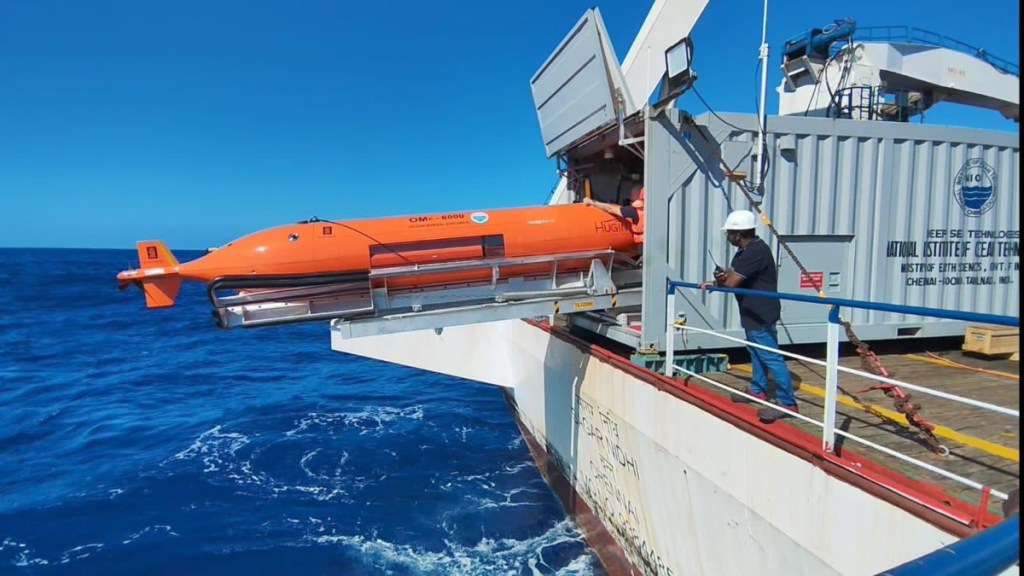India’s ambitious Deep Ocean Mission has achieved a groundbreaking milestone with the discovery of an active hydrothermal vent 4,500 meters below the surface of the Indian Ocean. This achievement is set to bolster scientists’ confidence and provide critical experience for future deep-sea explorations, according to the country’s leading ocean researchers.
What is Deep Sea Exploration?
In a joint effort by the National Institute of Ocean Technology (NIOT) and the National Centre for Polar and Ocean Research (NCPOR), Indian scientists captured the first-ever image of an active hydrothermal vent in the Indian Ocean. Thamban Meloth, Director of NCPOR, called the discovery a landmark moment for India’s Rs 4,000-crore Deep Ocean Mission, which aims to uncover new minerals, study unique ecosystems, and advance understanding of the ocean’s role in climate change.
“Seeing is believing,” Meloth remarked. “This discovery validates investments in the blue economy and strengthens confidence in continued exploration efforts.”
The Science Behind Hydrothermal Vents
Hydrothermal vents, often described as underwater hot springs, form along mid-ocean ridges where tectonic plates diverge. Magma from the Earth’s mantle rises, creating new crust and volcanic mountain chains. Seawater seeps into the crust, heats up, and shoots back out, carrying dissolved minerals that solidify into chimney-like structures when they meet cold seawater.
The first hydrothermal vent was discovered in 1977 on the Galapagos Rift, but this is India’s first direct observation of such a phenomenon.
Hydrothermal vents are valuable for two primary reasons:
Why Hydrothermal Vents Matter
- Mineral Resources: These vents produce rare minerals like nickel, cobalt, and manganese, essential for modern technology and clean energy solutions.
- Unique Ecosystems: They host life forms that thrive without sunlight, relying on chemosynthesis—a process where organisms convert inorganic chemicals like hydrogen sulfide into energy.
“This discovery opens up opportunities to study life forms in extreme conditions, offering potential insights into the origins of life on Earth,” Meloth said.
India’s Exploration Challenges and Success
The discovery follows four expeditions over the past two years, with scientists relying on an Autonomous Underwater Vehicle (AUV) to navigate rugged underwater terrains and capture high-resolution images.
“The Indian Ocean is like searching for a needle in a haystack,” Meloth explained, referring to the vast area and challenging conditions. With depths of 3,000 to 5,000 meters and complete darkness, the search is arduous.
The Southern Ocean’s extreme weather, ocean currents, and windy conditions further complicate operations. “During a one-month survey, we might get only one or two weeks of suitable weather,” Meloth noted.
India is building a new ship for deep-sea surveys, expected to be ready within three years as part of the Deep Ocean Mission. This will enable more advanced studies of the Indian Ocean’s Central and Southern Ridges, home to hydrothermal vents and potential mineral reserves.
“This is just the beginning,” Meloth said, emphasising the need for sustained support to continue uncovering the mysteries of the deep ocean.
The discovery also offers a unique opportunity to study the role of chemosynthesis in supporting life in extreme environments. Russian biochemist Aleksandr Oparin’s chemosynthetic theory of life’s origin, proposed in 1922, posits that life may have originated in water through chemical reactions—a hypothesis reinforced by studying hydrothermal vent ecosystems.
Despite the success, the sheer scale of the Indian Ocean and the precision required to locate small vents present significant challenges. The instruments must be highly accurate, and finding these vents often requires a combination of experience and luck.
However, with advancements in technology and growing expertise, India is well-positioned to make significant strides in deep-sea exploration, contributing to global knowledge and resource development.
India’s Deep Ocean Mission is not just a technological or scientific achievement; it is a testament to the country’s commitment to exploring the unknown and unlocking the ocean’s secrets.

